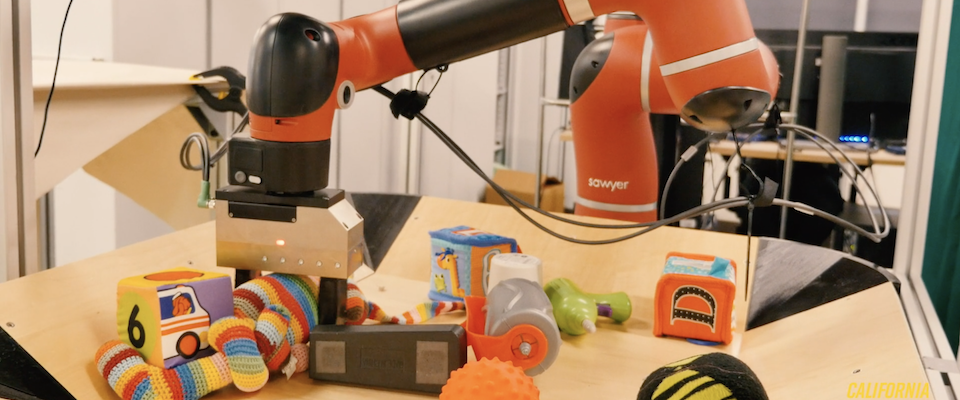For all the loose talk about the Singularity and Skynet, it’s pretty clear we have a long way to go before we’re in the thrall of a malign artificial intelligence (AI) intent on harnessing us for our precious mammalian bio-electricity, à la The Matrix. Still, some of the robots at the Berkeley Artificial Intelligence Research (BAIR) Lab are liable to send a frisson down your spine. It’s not that they’re muttering “Kill all humans” or fabricating laser swords. They’re not necessarily even humanoid. They’re just big, brightly colored armatures moving a lot of toddler toys—blocks and such—around. Over and over again, in different configurations.
As with human beings, robots, it seems, benefit from an extensive education and stimulating surroundings.
They look like they’re playing, and indeed, says Sergey Levine, an assistant professor at UC Berkeley’s Department of Electrical Engineering and Computer Sciences, that’s pretty much what they’re doing. Unlike most robots, the ones in the BAIR Lab haven’t been programmed to perform a specific task—such as making a weld at a precise spot on a truck frame in an assembly line. Instead, they’ve been programmed to learn. More to the point, they’ve been programmed to learn new stuff by observation or through physical trial and error.
Play, of course, is the primary means by which youngsters learn about the world. And by manipulating—playing with—objects in the lab, the Berkeley AI robots are doing the same thing. When you watch the machines work—err, play—you’re watching them learn. You can literally see them figuring things out. And it’s a little eerie.
The process, a subset of machine learning, is called “domain-adaptive meta-learning.”
“It’s a generalized approach that allows the robots to develop a kind of common sense,” says Levine. “It’s not task-oriented or imitative. We’re not teaching a robot how to put a cap on a bottle. If we were, the robot would only know how to put a certain type of cap on a certain type of bottle.”
Instead, BAIR researchers are teaching robots the general concept of, for example, putting caps on bottles, then exposing them to different caps and bottles. The more experiences they accrue at manipulating different objects in different ways, the better they become at performing a wide range of tasks.
Levine and colleagues, including then-students Chelsea Finn, Ph.D. ’18, and Tianhe Yu ’18, have published recent papers on robot meta-learning, demonstrating that robots can acquire a variety of related skills from “viewing” a single video of a human demonstrating a specific undertaking. (They can also learn by observing live demonstrations or undergoing armature manipulation by a researcher.)

In other words, the robots don’t just understand the precise task being demonstrated, they can figure out ways the movements associated with the task might be applied to other situations. And it’s not just a matter of one robot seeing and doing—it’s more like what one robot sees, all robots can do.
“These techniques are scalable,” says Finn. “Robotic systems can be linked, so when one robot masters certain learning skills, it can communicate them to others. They don’t have to learn serially. They can learn in parallel, sharing their skills.
Humans, too, learn in parallel—kinda, sorta. Levine emphasizes that BAIR’s robots “are the result of a team effort, not just Chelsea and me. A lot of students have been involved in a direct and collaborative way. We found time and again that if one of us was stuck, someone else would have an idea that could move us forward.”
As with human beings, robots, it seems, benefit from an extensive education and stimulating surroundings.
“In order to test the limits of these [meta-learning] algorithms, we’re always trying to broaden the set of tasks and [enrich] the environment, to bring the objects they manipulate and the demonstrations they observe ever closer to real-world situations,” says Finn, gazing affectionately at the robots in their BAIR playpens.
But, as cool as it is, autonomous learning isn’t the goal. “Capability, not the learning, is the milestone,” Levine stresses.
And not to anthropomorphize these utterly soulless mechanisms, but—well, they appear to have moods.
“They can become temperamental,” says Levine with a faint smile. “Some days, they definitely seem more inclined to learn than others.”
When you watch the machines work—err, play—you’re watching them learn. You can literally see them figuring things out.
So, when will robots evolve from witless drones into true Renaissance machines? Certainly, it’s tempting to anticipate the perfect robot butler, meeting you at the threshold with a flawless martini and some witty repartee. But don’t hold your breath. “That kind of sci-fi scenario is appealing, but it’d be tough,” says Levine, as homes are very complicated environments. More likely the initial applications might be in restaurants and offices where a robot would respond to a much more limited set of situations.
Still, progress is being made, and the BAIR team has elicited considerable interest. Last year, the group trundled one of their robots to the 32nd annual Conference on Neural Information Processing Systems, and it was a big hit.
“People were very curious and eager to interact with it,” says Finn. “They were always trying to figure out ways to trick it. Which wasn’t hard.”
Just wait.
Glen Martin is a regular contributor to California and not a writing algorithm at all.



















